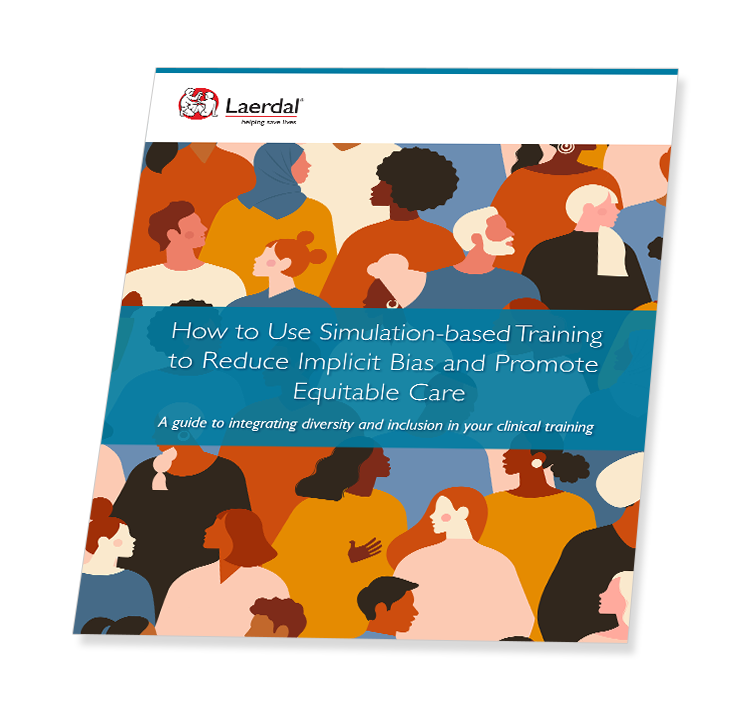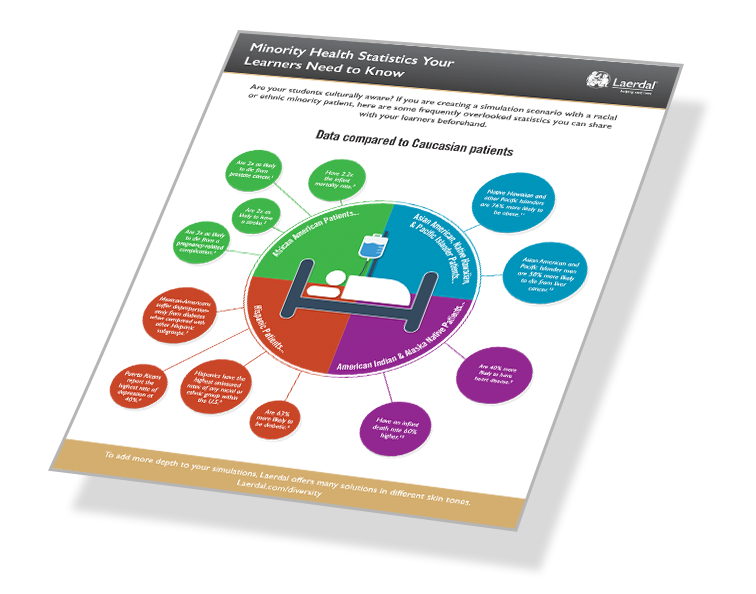
[eBook] How to Use Simulation-based Training to Reduce Implicit Bias and Promote Equitable Care
Read more about how to integrate diversity and inclusion in your clinical training to promote equitable care practices.
In the United States, approximately 36% of the population belongs to a racial or ethnic minority group – and this percentage is only expected to grow.1 As the U.S. becomes increasingly diverse, so too does the patient population. And, this should affect how healthcare professionals train for their roles.
Compared with white patients, members of racial and ethnic minorities are less likely to receive preventative health services and often receive lower-quality care.2 Even after considering income, neighborhood, and health insurance – factors typically used to explain racial disparities – black patients still had poorer health outcomes than white patients.3 To combat health disparities, experts say that providers must acknowledge that both structural racism and implicit biases exist in healthcare.4
The data shows that the U.S. population will only continue to become more diverse, and this means that the method of treating all patients the same is expected to dissolve entirely. Simulation training is often praised for the opportunity it gives learners to interact with a “real” patient. Why not enhance this realism by using a patient profile that is whole – complete with racial, ethnic, socioeconomic, geographical, and religious differences?
Below, we share how simulation can prepare your learners to treat patients who are part of a racial or ethnic minority. Specifically, we focus on the importance of developing cultural competence and a sensitivity to health literacy in patients. By focusing your training efforts on treating minority patients and creating an awareness of existing health disparities, your learners will inevitably improve in their ability to treat all patients.
Quick Reference
Before you set up a simulation specific to diversity training, it can help to ensure that your learners have a grasp on the severity of the state of minority health. Download our infographic, “Minority Health Statistics Your Learners Need to Know,” for a quick-reference guide of current statistics.

Racial and ethnic minorities represent more than 25% of the total U.S. population, but only 10% of the nation’s healthcare providers.5 While healthcare systems are keenly aware that diversifying staff and leadership positions is critical, experts also point to a need to educate all providers to recognize why cultural differences matter.
Culturally-competent, patient-centered care focuses on each patient’s cultural differences, needs, values, preferences, and individualized care provisions as a method of reaching the best possible patient outcome.6 It is not so much an end-point to strive for as it is an ongoing learning process for healthcare professionals. The good news is that developing cultural competence does not require providers to be of the same race or ethnicity as their patients. It does, however, require that providers adapt how they communicate with, assess, and diagnose their individual patients.
A healthcare provider's knowledge, understanding and skills for treating patients
A healthcare professional's patient satisfaction
It can be difficult to teach cultural competence through textbooks and lecture alone. Research shows that it is best learned over time and should involve a self-reflection process.8 Simulation can help to create a learning environment that is representative of the diverse society learners will be serving. And, simulation debrief can provide a setting that is conducive for each learner to reflect on their attitudes and behaviors.
A bi-national study showed that nursing students improved in their cultural awareness after participating in a simulation experience.9 In this study, learners used an assessment checklist as a guide to understand their simulated patients. While the checklist reinforced questions and observations that are important in a cross-cultural (or any) patient interaction, the simulation itself provided the opportunity to put theory into practice.
The simulated patient is a Cherokee Indian woman with a complaint of abnormal menstrual bleeding who is resistant to gynecologic care from male providers. Following the simulation, learners discover that they misdiagnosed and mishandled the patient. They realized their inability to detect cultural cues and the impact that had on their patient’s overall care.10
Simulation can help create an eye-opening learning experience, leading to greater self-awareness in students who might otherwise be hard to reach. The cultural competence they can glean from simulation training can ultimately save the lives of minority patients.
A message said is not necessarily a message understood. For patient-provider interactions, in which healthcare professionals can often overestimate a patient’s health literacy, this can be very true. Depending on a patient’s understanding of their own health and a provider’s ability to communicate information in laymen terms, a lot of context can be missed.
From self-reported health knowledge, to preventative behaviors, chronic disease management, and hospitalization, individuals with limited health literacy fare worse than health literate ones.11 Even more unsettling is that minority racial and ethnic groups, and those who are socioeconomically disadvantaged, elderly or immigrants, are disproportionately limited in their health literacy.12 This can lead to patients avoiding care entirely, non-adherence to medication, higher medical costs, and an inefficient path to recovery.13,14
An estimated 41% of Latinos lack basic health literacy skills.15 |
For healthcare professionals (currently practicing or in-training), this is an area that simulation training can offer vast improvement. In addition to developing cultural competence, learners can deliberately work to strengthen their interpersonal communication skills to facilitate healthy patient-provider conversations. This can include earning a patient’s trust, helping a patient communicate his or her needs, and facilitating shared decision-making when weighing treatment options.16
Research of baccalaureate nursing students showed that simulation evoked learners’ empathy and impacted their future communication with patients.17 A separate study showed that clinical simulation can be used to elicit students’ attitudes toward cross-cultural situations and subsequently improve communication and nursing skills.18 By developing learner empathy and skills, providers are better prepared to interview, communicate medical information, and provide treatment to patients from diverse ethnic and racial backgrounds.
If you’re looking at ways for your learners to develop in their sensitivity toward patients of a racial or ethnic minority, you may want to consider simulation training as a solution. Learners can enhance their patient assessment skills by taking a mindful approach to health literacy, which may lead to more accurate diagnoses, better medication adherence, and more lives saved.
Based on projections by the U.S. Bureau of Labor Statistics (BLS), the country will need an additional 203,200 registered nurses (RNs) each year from now through 2031, to replace nurses retiring or transferring to other occupations.19 And, by this time, more than half of the nation’s children are expected to be part of a minority race or ethnic group.20 This means that increasing the number of providers and diversifying providers are important goals for healthcare. However, experts say that it is equally (if not more) important to increase the diversity and cultural competency of those providers.21
To effectively train the next generation of healthcare providers, and to prepare them to treat patients of all backgrounds, Laerdal is committed to developing our most popular simulation solutions in different skin tones. When using simulation to train for diverse patient bodies, learners should know the impact of cultural characteristics on a patient’s care. A simulator in a darker skin tone serves to add realism to the situation, rather than relying on sole imagination.
Above all things, simulation can help to develop your learners into vigilant healthcare professionals who are meticulous in their observations. First, you must bring learners from a state of “unconscious incompetence” to “conscious incompetence”; only then can you coach them to become fully-competent healthcare providers.
Learners can begin to value the impact of their cultural understanding and apply that understanding to their life-saving role. Training to care for various ethnic and racial backgrounds inevitably improves care for all.
*Office of Minority Health. (2016). Stroke and African americans. U.S. Department of Health and Human Services. Retrieved from https://minorityhealth.hhs.gov/omh/browse.aspx?lvl=4&lvlid=28
**Howard, C. (2018). The state of minority mental health. Mental Health First Aid. Retrieved from https://www.mentalhealthfirstaid.org/external/2018/04/state-minority-mental-health/
***Families USA. (2019). Racial and ethnic health inequities among communities of color compared to non-Hispanic whites. Retrieved from https://familiesusa.org/product/racial-and-ethnic-health-inequities-among-communities-color-compared-non-hispanic-whites